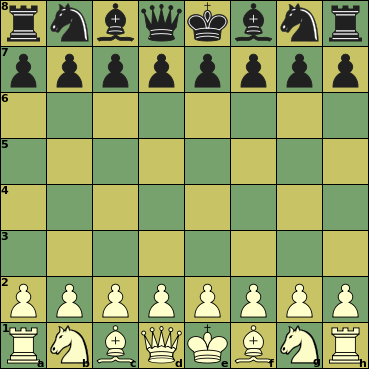Losers Chess
 |
Initial setupe1, e8: King |
Moves at a Glance
Click on a piece below to see its moves
 |
 |
 |
 |
Sliding capture or non-capture, can be blocked on any square along the ray |
|||||||
 |
Unblockable leap (capture or non-capture) | ||||||||||
 |
Non-capture only | ||||||||||
 |
Capture only | ||||||||||
 |
 |
 |
 |
 |
 |
 |
|||||
 |
|||||||||||
:
:
:
:
| Piece | ID | value | Moves (Betza notation) | Remarks |
| King | K | - | K | Can castle with Rook, moving 2 steps towards it |
| Queen | Q | 9.5 | RB or Q | |
| Rook | R | 5 | R | |
| Bishop | B | 3.25 | B | Color-bound |
| Knight | N | 3.25 | N | |
| Pawn | P | 1 | mfWcfF | Promotes to Q, R, B, or N on reaching last rank |
Pawn peculiarities
- Pawns capture differently from how they move (straight move, diagonal capture).
- Pawns can move two squares straight ahead from their initial position, provided they are not blocked.
- On the move immediately after such a double push, they can be captured en passant by another Pawn, as if they had only moved 1 square ahead.
- Pawns promote to another (non-royal) piece of choice when they reach last rank.
Castling
A King that has not moved before can move two squares in the direction of a Rook that has not moved before, in which case that Rook is moved to the square the King skipped over. This is only allowed if all squares between King and Rook are empty, when the King is not in check on the square it came from, and would not be in check on any of the squares it skipped over.
General rules
- Capture is mandatory; if ay capture is possible, you cannot play a non-capture.
- It is not allowed to expose your King to check.
- The game is won by being checkmated or being left with a bare King.
- Stalemate (no legal moves, but not in check) is a draw.
Differences with FIDE
Capture is mandatory. You win by being checkmated in stead of checkmating, or by having a bare King.
Strategy issues
Initially having more and stronger pieces makes you more likely to win.
When the opponent has only King and Pawns left, blocking one of his Pawns (e.g. with Knight or Bishop), and then carefully refraining from attacking it while using your powerful pieces to shephard his King towards your own Pawns, and then finally sacrificing your mobile material to it, is a good way to win.